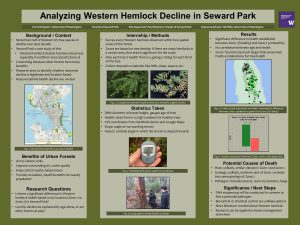Analyzing Western Hemlock Decline in Seward Park
Urban forests offer a multitude of benefits, human-centered and otherwise. Seattle’s largest urban forest, Seward Park, has witnessed a significant decline in Western hemlocks over the past few years. This is part of a sobering, nationwide trend in tree deaths. We analyzed the spatial range of decline and determine whether the cause of the tree mortality was old age or another factor. Over a span of ten weeks, we surveyed over 700 trees in the forest, giving each of them a health rating, along with other descriptive statistics. Two survey sites were established at the beginning of the study, and we surveyed every tree we could find within those sites. Near the end of the survey, we used a density function to redefine the sites. The healthier region was significantly wider than we first predicted. Health ratings were taken, along with other descriptive statistics including DBH, slope, aspect and geographic coordinates. A large difference in health between the two areas was observed. This difference in health was not determined by age, as there was no correlation between diameter and health. This implies that a different factor is at play. Further research, including DNA sequencing, may inform us if there is a pathogen infecting the trees. Other possibilities, such as differing geology or climatic conditions, have been discarded. Western hemlocks are often overlooked in scholarly literature despite their abundance in Washington State, so further research will support management efforts elsewhere.
